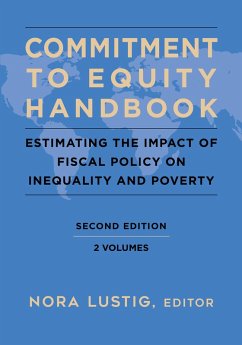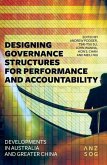Commitment to Equity Handbook
Estimating the Impact of Fiscal Policy on Inequality and Poverty
Herausgeber: Lustig, Nora
Commitment to Equity Handbook
Estimating the Impact of Fiscal Policy on Inequality and Poverty
Herausgeber: Lustig, Nora
- Broschiertes Buch
- Merkliste
- Auf die Merkliste
- Bewerten Bewerten
- Teilen
- Produkt teilen
- Produkterinnerung
- Produkterinnerung
This unique manual provides policymakers, social planners, and economists with salient aspects of fiscal redistribution theory, a step-by-step guide to applying fiscal incidence analysis including the required software, a variety of country studies to illustrate, and data on fiscal redistribution for a large number of countries around the world.
Andere Kunden interessierten sich auch für
![Choosing to Engage Choosing to Engage]() Rebecca DahlChoosing to Engage21,99 €
Rebecca DahlChoosing to Engage21,99 €![Designing Governance Structures for Performance and Accountability: Developments in Australia and Greater China Designing Governance Structures for Performance and Accountability: Developments in Australia and Greater China]() Designing Governance Structures for Performance and Accountability: Developments in Australia and Greater China33,99 €
Designing Governance Structures for Performance and Accountability: Developments in Australia and Greater China33,99 €![Democracy and Public Administration Democracy and Public Administration]() Richard C BoxDemocracy and Public Administration66,99 €
Richard C BoxDemocracy and Public Administration66,99 €![The Entrepreneurial State The Entrepreneurial State]() Mariana MazzucatoThe Entrepreneurial State14,99 €
Mariana MazzucatoThe Entrepreneurial State14,99 €![Government Aid To Home Owning And Housing Of Working People In Foreign Countries Government Aid To Home Owning And Housing Of Working People In Foreign Countries]() Government Aid To Home Owning And Housing Of Working People In Foreign Countries16,99 €
Government Aid To Home Owning And Housing Of Working People In Foreign Countries16,99 €![New York City's Progress Towards Bankruptcy: A Communication Addressed To Hon. Martin Saxe, Member Of The Joint Legislative Committee, Appointed To Ex New York City's Progress Towards Bankruptcy: A Communication Addressed To Hon. Martin Saxe, Member Of The Joint Legislative Committee, Appointed To Ex]() Edgar J. LeveyNew York City's Progress Towards Bankruptcy: A Communication Addressed To Hon. Martin Saxe, Member Of The Joint Legislative Committee, Appointed To Ex14,99 €
Edgar J. LeveyNew York City's Progress Towards Bankruptcy: A Communication Addressed To Hon. Martin Saxe, Member Of The Joint Legislative Committee, Appointed To Ex14,99 €![IRS Historical Fact Book: A Chronology, 1646-1992 IRS Historical Fact Book: A Chronology, 1646-1992]() IRS Historical Fact Book: A Chronology, 1646-199222,99 €
IRS Historical Fact Book: A Chronology, 1646-199222,99 €-
-
-
This unique manual provides policymakers, social planners, and economists with salient aspects of fiscal redistribution theory, a step-by-step guide to applying fiscal incidence analysis including the required software, a variety of country studies to illustrate, and data on fiscal redistribution for a large number of countries around the world.
Produktdetails
- Produktdetails
- Verlag: Bloomsbury Academic
- 2nd edition
- Seitenzahl: 1438
- Erscheinungstermin: 1. Mai 2023
- Englisch
- Abmessung: 254mm x 182mm x 62mm
- Gewicht: 2654g
- ISBN-13: 9780815740469
- ISBN-10: 0815740468
- Artikelnr.: 67405357
- Herstellerkennzeichnung
- Libri GmbH
- Europaallee 1
- 36244 Bad Hersfeld
- gpsr@libri.de
- Verlag: Bloomsbury Academic
- 2nd edition
- Seitenzahl: 1438
- Erscheinungstermin: 1. Mai 2023
- Englisch
- Abmessung: 254mm x 182mm x 62mm
- Gewicht: 2654g
- ISBN-13: 9780815740469
- ISBN-10: 0815740468
- Artikelnr.: 67405357
- Herstellerkennzeichnung
- Libri GmbH
- Europaallee 1
- 36244 Bad Hersfeld
- gpsr@libri.de
Nora Lustig is Samuel Z. Stone Professor of Latin American Economics and founding Director of the Commitment to Equity Instituteat Tulane University where she researches the impact of taxation and social spending on inequality and poverty, and the determinants of inequality. Her more recent work has focused on the short- and long-term impacts of COVID-19 on educational mobility, inequality, and poverty.
VOLUME 1
List of Illustrations
Foreword
François Bourguignon
Acknowledgments
CEQ Handbook
Nora Lustig
Abstracts
Introduction
1 About Volume 1: Fiscal Incidence Analysis: Methodology, Implementation,
and Applications
2 The Relevance of Fiscal Incidence Analysis in Today's World
3 Fiscal Incidence in Practice: The Commitment to Equity (CEQ) Assessment
4 Main Messages
5 Organization of Volume 1
6 Implementing a CEQ Assessment: How to Use Volume 1
7 CEQ Assessment: Data Requirements
8 About Volume 2: Methodological Frontiers in Fiscal Incidence Analysis
9 About the CEQ Institute
10 About the CEQ Data Center on Fiscal Redistribution
VOLUME 2
List of Illustrations
Abstracts
Alternative Methods to Value Transfers in Kind:
Health, Education, and Infrastructure
Chapter 1: The Effect of Government Health Expenditure on Income
Distribution: A Comparison of Valuation Methods in Ghana
by Jeremy Barofsky and Stephen D. Younger
Introduction
1 What's Wrong with the Cost of Provision?
2 Using Healthcare Consumers' Choices to Estimate the Compensating
Variation for Public Healthcare Expenditures
3 The Health Outcomes Approach
4 Summary: Choosing among the Options
5 Insurance Value of Financial Risk Reduction
6 Conclusion
Appendix 1A
1 Using the Spectrum Policy Models Software
2 Financial Risk Protection with Consumption Floor Proportional to Income
3 Concentration Curves by Valuation Method
4 Using Willingness and Ability to Pay by Matching Publicly Funded Health
Services to Private Health Services
5 Data and Do-Files for Replication
Chapter 2: The Market Value of Public Education: A Comparison of
Three Valuation Methods
by Sergei Soares
Introduction
1 First Method: Schooling Is Worth What It Costs the State to Provide It
2 Second Method: Schooling Is Worth What the Labor Market Says It Is Worth
3 Third Method: Schooling Is Worth What the Private Education Market Says
It Is Worth
4 Comparison of Results
5 Conclusion
Chapter 3: Redistribution through Education: Assessing the Long-Term
Impact of Public Spending
by Sergio Urzua
Introduction
1 The Conceptual Framework
2 The Value of Public Education Spending to Its Beneficiaries
3 Chile and Ghana: Differences and Similarities 77
4 Empirical Analysis
5 Conclusions 105
Appendix 3A Dynamic Fiscal Incidence of Public Spending
in Education 111
1 The Recursive Problem
2 Intertemporal Fiscal Incidence Analysis
Appendix 3B Instrumental Variable
Chapter 4: The Market Value of Owner-Occupied Housing and Public
Infrastructure Services
by Sergei Soares
Introduction
1 Literature
2 Methodology
3 Imputing Rents and Public Infrastructure Services for 2015
4 Comparisons with 2005 and 1995
5 Conclusions
Fiscal Incidence of Corporate Taxes
Chapter 5: Taxes, Transfers, and Income Distribution in Chile:
Incorporating Undistributed Profits
by Bernardo Candia and Eduardo Engel
Introduction
1 Tax Regime and Social Spending in Chile
2 Data, Methodology, and Assumptions
3 Results
4 Marginal Contribution and Shapley Value
5 Distributive Effects of the 2014 Tax Reform
6 Conclusions
Redistributive Impact of Contributory Pensions
Chapter 6: The Within-System Redistribution of Contributory Pension
Systems: A Conceptual Framework and Empirical Method of Estimation
by Carlos Grushka
Introduction
1 Are Pension Systems Tax-Transfers or Deferred Wages Schemes?
2 Redistribution, Neutrality, and Actuarial Fairness
3 Social Security Pensions in Argentina
4 How Redistribution Works for Social Security Pensions in Argentina
5 An Alternative Methodological Framework
6 Conclusion
Fiscal Redistribution and Sustainability
Chapter 7: Intertemporal Sustainability of Fiscal Redistribution: A
Methodological Framework
by Jose Maria Fanelli
Introduction
1 Income Concepts, Fiscal Redistributions, and Sustainability
2 Fiscal Redistributions, Demography, and Wealth Constraints
3 Fiscal Redistributions and Income Strata
4 Concluding Remarks
Appendix 7A Pensions as Deferred Income
1 Income Strata and Deferred Income
2 Private Wealth and Forced Savings
3 Demography and Wealth
Appendix 7B Nomenclature
Chapter 8: Fiscal Redistribution, Sustainability, and Demography in Latin
America
by Ramiro Albrieu and Jose Maria Fanelli
Introduction
1 Fiscal Policy and Redistribution Outcomes
2 Fiscal Redistributions and Debt Sustainability
3 The Future Sustainability of Fiscal Policy in Aging Societies
4 Conclusion
Political Economy of Redistribution
Chapter 9: On the Political Economy of Redistribution and Provision of
Public Goods
by Stefano Barbieri and Koray Caglayan
Introduction
1 The Meltzer and Richard (1981) Pure Redistribution Model
2 Assumptions of Linear Tax Rates and the Importance of Public Provision
3 The Provision of Public Goods Using a Median Voter Framework
4 Extension to Nonlinear Tax Schemes
5 The Provision of Public Goods Financed with a Flat Tax with Exemptions
6 Taxation and Redistribution Models without Functional Form Assumptions
7 Conclusion
Appendix 9A Technical Derivations of the Meltzer and Richard (1981) Model
1 Response of Consumption to Government Transfers
2 Response of Pretax Income to Productivity
Appendix 9B Technical Derivations of Lambert (2001)
About the Authors
Index
List of Illustrations
Foreword
François Bourguignon
Acknowledgments
CEQ Handbook
Nora Lustig
Abstracts
Introduction
1 About Volume 1: Fiscal Incidence Analysis: Methodology, Implementation,
and Applications
2 The Relevance of Fiscal Incidence Analysis in Today's World
3 Fiscal Incidence in Practice: The Commitment to Equity (CEQ) Assessment
4 Main Messages
5 Organization of Volume 1
6 Implementing a CEQ Assessment: How to Use Volume 1
7 CEQ Assessment: Data Requirements
8 About Volume 2: Methodological Frontiers in Fiscal Incidence Analysis
9 About the CEQ Institute
10 About the CEQ Data Center on Fiscal Redistribution
VOLUME 2
List of Illustrations
Abstracts
Alternative Methods to Value Transfers in Kind:
Health, Education, and Infrastructure
Chapter 1: The Effect of Government Health Expenditure on Income
Distribution: A Comparison of Valuation Methods in Ghana
by Jeremy Barofsky and Stephen D. Younger
Introduction
1 What's Wrong with the Cost of Provision?
2 Using Healthcare Consumers' Choices to Estimate the Compensating
Variation for Public Healthcare Expenditures
3 The Health Outcomes Approach
4 Summary: Choosing among the Options
5 Insurance Value of Financial Risk Reduction
6 Conclusion
Appendix 1A
1 Using the Spectrum Policy Models Software
2 Financial Risk Protection with Consumption Floor Proportional to Income
3 Concentration Curves by Valuation Method
4 Using Willingness and Ability to Pay by Matching Publicly Funded Health
Services to Private Health Services
5 Data and Do-Files for Replication
Chapter 2: The Market Value of Public Education: A Comparison of
Three Valuation Methods
by Sergei Soares
Introduction
1 First Method: Schooling Is Worth What It Costs the State to Provide It
2 Second Method: Schooling Is Worth What the Labor Market Says It Is Worth
3 Third Method: Schooling Is Worth What the Private Education Market Says
It Is Worth
4 Comparison of Results
5 Conclusion
Chapter 3: Redistribution through Education: Assessing the Long-Term
Impact of Public Spending
by Sergio Urzua
Introduction
1 The Conceptual Framework
2 The Value of Public Education Spending to Its Beneficiaries
3 Chile and Ghana: Differences and Similarities 77
4 Empirical Analysis
5 Conclusions 105
Appendix 3A Dynamic Fiscal Incidence of Public Spending
in Education 111
1 The Recursive Problem
2 Intertemporal Fiscal Incidence Analysis
Appendix 3B Instrumental Variable
Chapter 4: The Market Value of Owner-Occupied Housing and Public
Infrastructure Services
by Sergei Soares
Introduction
1 Literature
2 Methodology
3 Imputing Rents and Public Infrastructure Services for 2015
4 Comparisons with 2005 and 1995
5 Conclusions
Fiscal Incidence of Corporate Taxes
Chapter 5: Taxes, Transfers, and Income Distribution in Chile:
Incorporating Undistributed Profits
by Bernardo Candia and Eduardo Engel
Introduction
1 Tax Regime and Social Spending in Chile
2 Data, Methodology, and Assumptions
3 Results
4 Marginal Contribution and Shapley Value
5 Distributive Effects of the 2014 Tax Reform
6 Conclusions
Redistributive Impact of Contributory Pensions
Chapter 6: The Within-System Redistribution of Contributory Pension
Systems: A Conceptual Framework and Empirical Method of Estimation
by Carlos Grushka
Introduction
1 Are Pension Systems Tax-Transfers or Deferred Wages Schemes?
2 Redistribution, Neutrality, and Actuarial Fairness
3 Social Security Pensions in Argentina
4 How Redistribution Works for Social Security Pensions in Argentina
5 An Alternative Methodological Framework
6 Conclusion
Fiscal Redistribution and Sustainability
Chapter 7: Intertemporal Sustainability of Fiscal Redistribution: A
Methodological Framework
by Jose Maria Fanelli
Introduction
1 Income Concepts, Fiscal Redistributions, and Sustainability
2 Fiscal Redistributions, Demography, and Wealth Constraints
3 Fiscal Redistributions and Income Strata
4 Concluding Remarks
Appendix 7A Pensions as Deferred Income
1 Income Strata and Deferred Income
2 Private Wealth and Forced Savings
3 Demography and Wealth
Appendix 7B Nomenclature
Chapter 8: Fiscal Redistribution, Sustainability, and Demography in Latin
America
by Ramiro Albrieu and Jose Maria Fanelli
Introduction
1 Fiscal Policy and Redistribution Outcomes
2 Fiscal Redistributions and Debt Sustainability
3 The Future Sustainability of Fiscal Policy in Aging Societies
4 Conclusion
Political Economy of Redistribution
Chapter 9: On the Political Economy of Redistribution and Provision of
Public Goods
by Stefano Barbieri and Koray Caglayan
Introduction
1 The Meltzer and Richard (1981) Pure Redistribution Model
2 Assumptions of Linear Tax Rates and the Importance of Public Provision
3 The Provision of Public Goods Using a Median Voter Framework
4 Extension to Nonlinear Tax Schemes
5 The Provision of Public Goods Financed with a Flat Tax with Exemptions
6 Taxation and Redistribution Models without Functional Form Assumptions
7 Conclusion
Appendix 9A Technical Derivations of the Meltzer and Richard (1981) Model
1 Response of Consumption to Government Transfers
2 Response of Pretax Income to Productivity
Appendix 9B Technical Derivations of Lambert (2001)
About the Authors
Index
VOLUME 1
List of Illustrations
Foreword
François Bourguignon
Acknowledgments
CEQ Handbook
Nora Lustig
Abstracts
Introduction
1 About Volume 1: Fiscal Incidence Analysis: Methodology, Implementation,
and Applications
2 The Relevance of Fiscal Incidence Analysis in Today's World
3 Fiscal Incidence in Practice: The Commitment to Equity (CEQ) Assessment
4 Main Messages
5 Organization of Volume 1
6 Implementing a CEQ Assessment: How to Use Volume 1
7 CEQ Assessment: Data Requirements
8 About Volume 2: Methodological Frontiers in Fiscal Incidence Analysis
9 About the CEQ Institute
10 About the CEQ Data Center on Fiscal Redistribution
VOLUME 2
List of Illustrations
Abstracts
Alternative Methods to Value Transfers in Kind:
Health, Education, and Infrastructure
Chapter 1: The Effect of Government Health Expenditure on Income
Distribution: A Comparison of Valuation Methods in Ghana
by Jeremy Barofsky and Stephen D. Younger
Introduction
1 What's Wrong with the Cost of Provision?
2 Using Healthcare Consumers' Choices to Estimate the Compensating
Variation for Public Healthcare Expenditures
3 The Health Outcomes Approach
4 Summary: Choosing among the Options
5 Insurance Value of Financial Risk Reduction
6 Conclusion
Appendix 1A
1 Using the Spectrum Policy Models Software
2 Financial Risk Protection with Consumption Floor Proportional to Income
3 Concentration Curves by Valuation Method
4 Using Willingness and Ability to Pay by Matching Publicly Funded Health
Services to Private Health Services
5 Data and Do-Files for Replication
Chapter 2: The Market Value of Public Education: A Comparison of
Three Valuation Methods
by Sergei Soares
Introduction
1 First Method: Schooling Is Worth What It Costs the State to Provide It
2 Second Method: Schooling Is Worth What the Labor Market Says It Is Worth
3 Third Method: Schooling Is Worth What the Private Education Market Says
It Is Worth
4 Comparison of Results
5 Conclusion
Chapter 3: Redistribution through Education: Assessing the Long-Term
Impact of Public Spending
by Sergio Urzua
Introduction
1 The Conceptual Framework
2 The Value of Public Education Spending to Its Beneficiaries
3 Chile and Ghana: Differences and Similarities 77
4 Empirical Analysis
5 Conclusions 105
Appendix 3A Dynamic Fiscal Incidence of Public Spending
in Education 111
1 The Recursive Problem
2 Intertemporal Fiscal Incidence Analysis
Appendix 3B Instrumental Variable
Chapter 4: The Market Value of Owner-Occupied Housing and Public
Infrastructure Services
by Sergei Soares
Introduction
1 Literature
2 Methodology
3 Imputing Rents and Public Infrastructure Services for 2015
4 Comparisons with 2005 and 1995
5 Conclusions
Fiscal Incidence of Corporate Taxes
Chapter 5: Taxes, Transfers, and Income Distribution in Chile:
Incorporating Undistributed Profits
by Bernardo Candia and Eduardo Engel
Introduction
1 Tax Regime and Social Spending in Chile
2 Data, Methodology, and Assumptions
3 Results
4 Marginal Contribution and Shapley Value
5 Distributive Effects of the 2014 Tax Reform
6 Conclusions
Redistributive Impact of Contributory Pensions
Chapter 6: The Within-System Redistribution of Contributory Pension
Systems: A Conceptual Framework and Empirical Method of Estimation
by Carlos Grushka
Introduction
1 Are Pension Systems Tax-Transfers or Deferred Wages Schemes?
2 Redistribution, Neutrality, and Actuarial Fairness
3 Social Security Pensions in Argentina
4 How Redistribution Works for Social Security Pensions in Argentina
5 An Alternative Methodological Framework
6 Conclusion
Fiscal Redistribution and Sustainability
Chapter 7: Intertemporal Sustainability of Fiscal Redistribution: A
Methodological Framework
by Jose Maria Fanelli
Introduction
1 Income Concepts, Fiscal Redistributions, and Sustainability
2 Fiscal Redistributions, Demography, and Wealth Constraints
3 Fiscal Redistributions and Income Strata
4 Concluding Remarks
Appendix 7A Pensions as Deferred Income
1 Income Strata and Deferred Income
2 Private Wealth and Forced Savings
3 Demography and Wealth
Appendix 7B Nomenclature
Chapter 8: Fiscal Redistribution, Sustainability, and Demography in Latin
America
by Ramiro Albrieu and Jose Maria Fanelli
Introduction
1 Fiscal Policy and Redistribution Outcomes
2 Fiscal Redistributions and Debt Sustainability
3 The Future Sustainability of Fiscal Policy in Aging Societies
4 Conclusion
Political Economy of Redistribution
Chapter 9: On the Political Economy of Redistribution and Provision of
Public Goods
by Stefano Barbieri and Koray Caglayan
Introduction
1 The Meltzer and Richard (1981) Pure Redistribution Model
2 Assumptions of Linear Tax Rates and the Importance of Public Provision
3 The Provision of Public Goods Using a Median Voter Framework
4 Extension to Nonlinear Tax Schemes
5 The Provision of Public Goods Financed with a Flat Tax with Exemptions
6 Taxation and Redistribution Models without Functional Form Assumptions
7 Conclusion
Appendix 9A Technical Derivations of the Meltzer and Richard (1981) Model
1 Response of Consumption to Government Transfers
2 Response of Pretax Income to Productivity
Appendix 9B Technical Derivations of Lambert (2001)
About the Authors
Index
List of Illustrations
Foreword
François Bourguignon
Acknowledgments
CEQ Handbook
Nora Lustig
Abstracts
Introduction
1 About Volume 1: Fiscal Incidence Analysis: Methodology, Implementation,
and Applications
2 The Relevance of Fiscal Incidence Analysis in Today's World
3 Fiscal Incidence in Practice: The Commitment to Equity (CEQ) Assessment
4 Main Messages
5 Organization of Volume 1
6 Implementing a CEQ Assessment: How to Use Volume 1
7 CEQ Assessment: Data Requirements
8 About Volume 2: Methodological Frontiers in Fiscal Incidence Analysis
9 About the CEQ Institute
10 About the CEQ Data Center on Fiscal Redistribution
VOLUME 2
List of Illustrations
Abstracts
Alternative Methods to Value Transfers in Kind:
Health, Education, and Infrastructure
Chapter 1: The Effect of Government Health Expenditure on Income
Distribution: A Comparison of Valuation Methods in Ghana
by Jeremy Barofsky and Stephen D. Younger
Introduction
1 What's Wrong with the Cost of Provision?
2 Using Healthcare Consumers' Choices to Estimate the Compensating
Variation for Public Healthcare Expenditures
3 The Health Outcomes Approach
4 Summary: Choosing among the Options
5 Insurance Value of Financial Risk Reduction
6 Conclusion
Appendix 1A
1 Using the Spectrum Policy Models Software
2 Financial Risk Protection with Consumption Floor Proportional to Income
3 Concentration Curves by Valuation Method
4 Using Willingness and Ability to Pay by Matching Publicly Funded Health
Services to Private Health Services
5 Data and Do-Files for Replication
Chapter 2: The Market Value of Public Education: A Comparison of
Three Valuation Methods
by Sergei Soares
Introduction
1 First Method: Schooling Is Worth What It Costs the State to Provide It
2 Second Method: Schooling Is Worth What the Labor Market Says It Is Worth
3 Third Method: Schooling Is Worth What the Private Education Market Says
It Is Worth
4 Comparison of Results
5 Conclusion
Chapter 3: Redistribution through Education: Assessing the Long-Term
Impact of Public Spending
by Sergio Urzua
Introduction
1 The Conceptual Framework
2 The Value of Public Education Spending to Its Beneficiaries
3 Chile and Ghana: Differences and Similarities 77
4 Empirical Analysis
5 Conclusions 105
Appendix 3A Dynamic Fiscal Incidence of Public Spending
in Education 111
1 The Recursive Problem
2 Intertemporal Fiscal Incidence Analysis
Appendix 3B Instrumental Variable
Chapter 4: The Market Value of Owner-Occupied Housing and Public
Infrastructure Services
by Sergei Soares
Introduction
1 Literature
2 Methodology
3 Imputing Rents and Public Infrastructure Services for 2015
4 Comparisons with 2005 and 1995
5 Conclusions
Fiscal Incidence of Corporate Taxes
Chapter 5: Taxes, Transfers, and Income Distribution in Chile:
Incorporating Undistributed Profits
by Bernardo Candia and Eduardo Engel
Introduction
1 Tax Regime and Social Spending in Chile
2 Data, Methodology, and Assumptions
3 Results
4 Marginal Contribution and Shapley Value
5 Distributive Effects of the 2014 Tax Reform
6 Conclusions
Redistributive Impact of Contributory Pensions
Chapter 6: The Within-System Redistribution of Contributory Pension
Systems: A Conceptual Framework and Empirical Method of Estimation
by Carlos Grushka
Introduction
1 Are Pension Systems Tax-Transfers or Deferred Wages Schemes?
2 Redistribution, Neutrality, and Actuarial Fairness
3 Social Security Pensions in Argentina
4 How Redistribution Works for Social Security Pensions in Argentina
5 An Alternative Methodological Framework
6 Conclusion
Fiscal Redistribution and Sustainability
Chapter 7: Intertemporal Sustainability of Fiscal Redistribution: A
Methodological Framework
by Jose Maria Fanelli
Introduction
1 Income Concepts, Fiscal Redistributions, and Sustainability
2 Fiscal Redistributions, Demography, and Wealth Constraints
3 Fiscal Redistributions and Income Strata
4 Concluding Remarks
Appendix 7A Pensions as Deferred Income
1 Income Strata and Deferred Income
2 Private Wealth and Forced Savings
3 Demography and Wealth
Appendix 7B Nomenclature
Chapter 8: Fiscal Redistribution, Sustainability, and Demography in Latin
America
by Ramiro Albrieu and Jose Maria Fanelli
Introduction
1 Fiscal Policy and Redistribution Outcomes
2 Fiscal Redistributions and Debt Sustainability
3 The Future Sustainability of Fiscal Policy in Aging Societies
4 Conclusion
Political Economy of Redistribution
Chapter 9: On the Political Economy of Redistribution and Provision of
Public Goods
by Stefano Barbieri and Koray Caglayan
Introduction
1 The Meltzer and Richard (1981) Pure Redistribution Model
2 Assumptions of Linear Tax Rates and the Importance of Public Provision
3 The Provision of Public Goods Using a Median Voter Framework
4 Extension to Nonlinear Tax Schemes
5 The Provision of Public Goods Financed with a Flat Tax with Exemptions
6 Taxation and Redistribution Models without Functional Form Assumptions
7 Conclusion
Appendix 9A Technical Derivations of the Meltzer and Richard (1981) Model
1 Response of Consumption to Government Transfers
2 Response of Pretax Income to Productivity
Appendix 9B Technical Derivations of Lambert (2001)
About the Authors
Index








